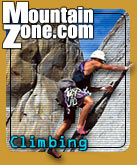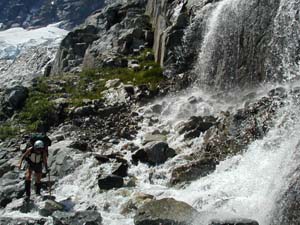
|
Searching for Solitude A seven-day traverse of the Cascades' North Pickets May 17, 2004
Pages »1 2
That first night at dinner I realized we were in trouble. Roy, my husband and climbing partner, asked for the bread and peanut butter while we waited for the freeze-dried rice and beans to cook. I calculated the rations and glanced at his hungry, hopeful face. Counting again, I pronounced the bad news. "Nope, we are officially rationing." We were eight hours into a seven-day traverse of the North Pickets, one of the wildest and unexplored ranges in the North Cascades. Our primary objective was Mt. Challenger. At 8,207 feet high, Challenger crowned a splendid line of hanging glaciers along the Luna Creek cirque. Named for its likeness to a picket fence, the Pickets range is spiked with the craggy, cold spires of Phantom Peak, Mt. Fury and Crooked Thumb on the north end, and the Twin Needles, Mt. Terror and Inspiration Peak to the south. Mt. Challenger is not particularly technical; the difficulty of Challenger is getting there. All three approaches are rated grade V on a scale of one to five. "Two grueling days of torture are required to get to Mt. Challenger," wrote Jim Nelson in his book, 'Selected Climbs in the Cascades.' "The approaches are all quite arduous. Each has its unique problems and punishment." We chose the Big Beaver Valley/Wiley Ridge loop, the most direct route but with "notorious and unsavory bushwhacking," according to Nelson. Five years earlier Roy attempted the Perfect Pass/Easy Ridge approach. After three days of pounding rain he and his two buddies turned back. Ever since, he'd lusted after Challenger. I was game to try, especially if "arduous and unique" meant no people, fresh mountain air and an athletic adventure. In late August we were ferried from Route 20 across Ross Lake to the Big Beaver trailhead. The sandy shoreline was dotted with newly planted native shrubs. As I admired a sprig of salal, a voracious cloud of mosquitoes descended on us. Arms flailing, we dug out the bug spray and soaked ourselves with the acidic liquid. We quickly shouldered our 50-pound packs and trudged north on the trail, slapping against the mosquitoes, which seemed impervious to Deet. Four miles in we stopped for lunch, and so did the cloud of mosquitoes. The trick was to stuff the tuna fish sandwiches and water into our mouths without inhaling a horde of stinging pests. We had coated ourselves with more bug spray and started up the trail when we heard a scratching noise in the trees. There! A young black bear clawed desperately up a fir tree, its legs pumping hard to pull away from where we stood. When it reached the top it looked around, whimpered, and shimmied the entire 50 feet back to earth. It hit the ground running and bounded into the bushes. "Cool!" Roy said. I wondered if the bear's mama was nearby. She could get aggressive if we got between them. But the next six miles were flat and uneventful. We arrived at Luna Camp sweaty, itchy and stinky, eight hours from Ross Lake. My shoulders and hips ached, and I dropped the pack gratefully to the soft ground. "Let's eat," I said. My stomach twitched with hunger as I pictured a steaming, salty pot of beans and rice. That's when Roy reached for the bread and peanut butter. On our last week-long climbing expedition, Roy had planned the menu. Good mountaineers always bring extra food, but we could have survived two more weeks with the food he piled into my pack. I carried out ten pounds of unused food, and vowed never to repeat that mistake. For the Pickets traverse, I took charge and planned down to the last carrot. The two food bags bulged with thousands of calories of oatmeal, sardines, cheese, beans, and candy bars. But bread with peanut butter was not on tonight's menu. After our sparse meal I squeezed out my tea bag and put it aside to re-use in the morning. As Roy nibbled on his last Fig Newton, I nudged the food bags out of sight under the tent. "Think of it as a weight loss program," I chided my trim, muscular husband. "Besides, there are plenty of berries." Our campsite was surrounded by a thick hedge of ripe blueberries. The black bear was most likely snacking on similar bushes earlier. The next morning, our stomachs loaded with oatmeal and berries, we left the predictable terrain of Big Beaver Trail, and headed west for the "notorious and unsavory bushwhacking" of Access Creek. Roy checked the map and started thrashing his way through the forest. Almost immediately we were stopped by the gurgling, icy creek. After twenty minutes of crashing through thickets and brambles, we found a series of slimy logs jammed several feet above the water that reached the other side. I dug my ice axe into the slippery bark and inched my way across.
For the next six hours I clambered over blown down trees, splashed through creeks tangled with slide alder, and pawed up slopes thick with thorny salmonberry and devil's club. The thorns scratched and punctured as I grabbed at them for balance. Branches whipped me in the face and a bee stung my leg after I stepped on a nest buried in a dry, rotten stump. After gaining only 2,000 feet in seven hours we emerged, exhausted, into a heather meadow. Thin lines of blood oozed from my knees and my shorts hung with sweat. Acidic, shiny spots of bug spray mixed with patches of dust on my formerly yellow shirt. My soggy socks rubbed my raw ankles as I took the last steps toward a flat, grassy area that would be our campsite. As soon as we dropped the packs, the black flies moved in. "Aarrgh!" Roy yelled, jumping in the grass and swatting the air around him. I opened a new bottle of bug spray and squirted it over his back and hair and down the back of his legs. I sank onto a rock for him to cover me. I was fed up with the bugs and beat up by the bushwhack. I was hungry and smelly and cranky. We covered ourselves in long pants and fleece for dinner. The flies still buzzed, but the Deet won out and we enjoyed a few moments of peace. Our campsite was nestled at the base of a towering cirque. The North Pickets form a U-shaped ridge, with Challenger on one end and Luna Peak on the other. Our goal tomorrow was Luna, which rose more than 6,000 feet straight above us. From there we would traverse the inner side of the U, across glaciers, rocks and frozen lakes to reach the base of Challenger, still two or three days away. Pink and purple heather and green-striped grasses reached from our campsite up the sloped rock wall toward Luna. The air smelled of warm rocks and sharp mountain air. Picas peeped and marmots whistled from the boulders while the sky blazed an orange and magenta trail behind the gray and white mountains. The next morning we set out to climb to the pass, which at 7,200 feet would put us on the U-shaped ridge. Roy checked the map, then headed west toward a 30-foot wide, vertical gully.
"I think so," he said. I tried to scramble up the ladder-like gully but loose rocks rolled out from under my boots and pulled free when I tested them for handholds. Flying ants appeared from nowhere and pierced my exposed arms and legs. My pack caught on gnarled twigs and I lurched and clambered hand-over-foot like a nervous monkey. Halfway up I paused for a drink. I loosened my pack and leaned it against the cliff, then freed the water bottle from the side pocket and drank deeply. But as I shrugged the shoulder straps back on, the pack slipped and I teetered, screaming, over the abyss. With one arm gripping my 50-pound pack and the other snatching a clump of exposed roots, I pulled myself back to the cliff and rested my head into the muddy slope. "Damn it!" I panted. Over the next hour the pitch tapered. I clawed my way out of the gushing gully to a safer scramble of rocks and grass to the pass, where Roy waited with a worried look. "I didn't think you'd like that part," he said. "I think we came up the wrong gully. It wasn't supposed to be that hard. But from here it might get easier." In fact, the heather meadows were so steep that other climbers had recommended wearing crampons to cross them. I caught my breath over another hasty lunch, batting at ants and black flies that had followed me up the gully. During the next three hours we dug the edges of our boots into the slope and gripped the stubby heather as a "vegetable belay." We crossed two snow fields and finally scrambled the class 3 talus to reach the summit of Luna, at 8,311 feet. Brilliant sun and gleaming mountains greeted us from all directions: Mt. Redoubt and the Canadian Coast mountains jutted on the northern horizon. Challenger, Fury and Terror towered along the Picket Range across the valley. The air was hot and still. And not another human being for miles. This was what I had come for. The beauty and simplicity erased the discomfort it took to get there. I felt lucky to be one of the few people to experience the magnitude and dramatic splendor of the Pickets. Out here I could empty my mind of stale worries and fill it with the purity of the outdoors: endless quiet, clear air and sparkling sky.
Page 2 »
|
||||||||||||||||

